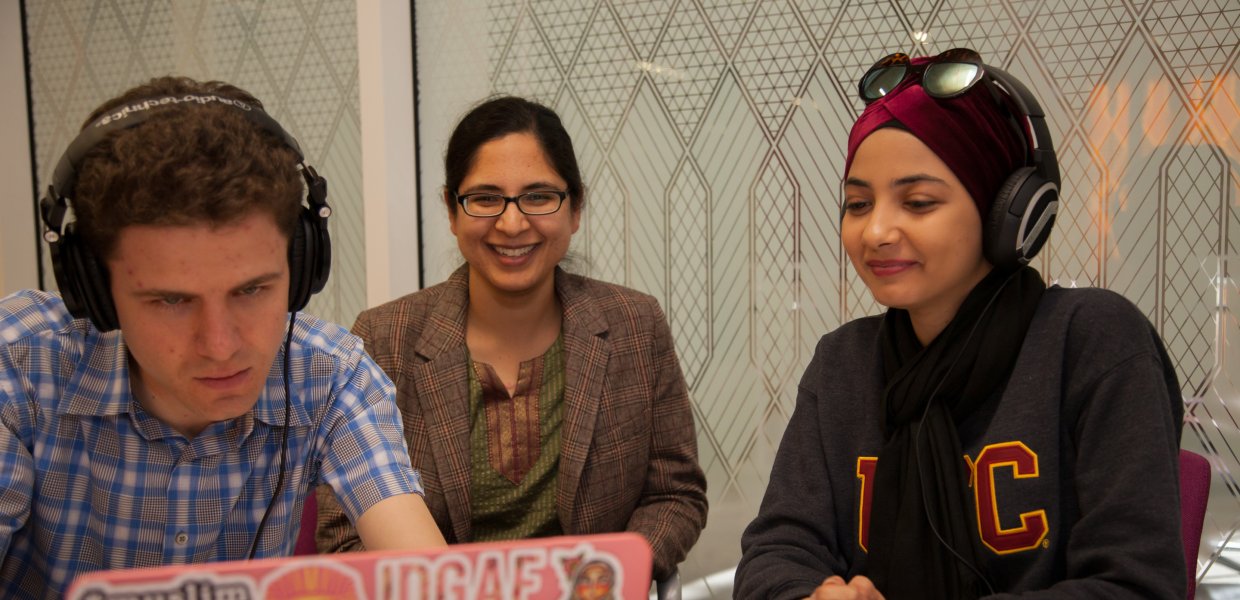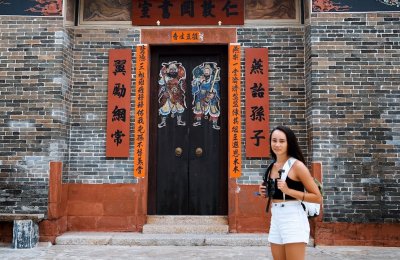Sitting in the USC Annenberg Digital Lounge during spring break, Noorhan Maamoon (B.A. Print and Digital Journalism ‘17) asked her mentor Sonia Narang questions about the script for her upcoming radio story. Nearby, other student and mentor pairs worked on laptops, with their headphones on. Cans of Playdoh, yoyo’s and balloons sat at a window sill in the room,to reduce stress.
Maamoon and four other students were part of the first NPR Next Generation Radio project hosted at USC Annenberg this month. Organized by the Institute for Diversity and Empowerment at Annenberg, the student and mentor pairs included four USC Annenberg students, and one student from Cal State Fullerton.
This is the third Next Generation Radio project this year, which has happened in other cities and radio stations across the country. Next Generation Radio was born out of an endeavor to reach out to students of color interested in public media. It started out as a side project for founder Doug Mitchell, who was an NPR producer for various shows including “Morning Edition,” and launched radio training projects at National Association of Black Journalists.
The premise of the project isn’t just about the next generation of young people, but also the next iteration of tools and content development, according to Mitchell.
“It’s almost like you want to say next generation quotation radio because while we do focus on audio storytelling, there is so much social media going on,” Mitchell said. “ [We are] teaching them proper uses of how to use social media for telling people what you are doing in a content development process.”
Mitchell said, fundamentally, he wants to find young people who want to work in public media but find them where they are — geographically and generationally.
The radio pieces, which were non-narrated stories similar to “This American Life,” tended to be about four minutes long. Story ideas ranged from a hula hooping festival to a five-star chef who gave up her career to put her culinary skills to work on Skid Row.
Maamoon and others learned different tools and methods to tell a story: reporting, compiling audio for the radio piece; using social media; shooting photos and videos; posting to the web and writing a web version of the radio story. All of the stories, including videos and photos, ended up on a mobile friendly website at the end of the week.
The Next Generation Radio project began in 2000, disbanded in 2008, and came back in 2013, according to Mitchell. Students competitively applied, and mentor and student teams were picked by Mitchell. For this project, Traci Tong was the managing editor of the project. Tong, who is one of the original and founding producer, is producer of The World — the co-production of the BBC World Service, PRI ( Public Radio International) and WGBH.
In order to apply for the program, radio experience was not necessary. Instead, Mitchell said they were looking for people who understood media.
Maamoon, who didn’t have any radio experience before the project, did a piece on a Muslim woman from Buena Park, Mirvette Judeh. About a year ago, Judeh decided to put on the hijab, or Muslim head covering, to combat the Islamaphobia she saw around her. Maamoon met her during a roundtable interview for KTLA News earlier this year.
Maamoon, who also wears hijab, followed Judeh around for a day, taking a peek into her life. She followed her as she grocery shopped, looked at scarves in her closet and picked her kids up from school. Maamoon noticed as they followed her during the day, Judeh would receive dirty looks from people around them. Maamoon herself had experienced negative reactions to hijab in Los Angeles.
“As a hijabi, when you’re alone, you will notice the looks but it’s easier to rationalize them and justify them ‘no they weren’t looking at me that way,’” she said. “As we were following her, she noticed it more and I noticed it more.”
Narang, Maamoon’s mentor, is an independent producer who contributes stories to PRI’s the World. She said she enjoyed seeing Maamoon get comfortable holding a mic, coached her on what questions to ask and when, and encouraged social media use in the field.
“Noorhan was so polite and Mirvette said, ‘I like you and if I like you, you’re in,’” Narang recalled. “I said ‘this is perfect.’ It was great to see them bond and connect. That’s how good radio is made — when you can connect and your interview subject lets you into their life.”
Another USC Annenberg student, Emily Lee (B.A. Broadcast Journalism ‘17) and her mentor, Jolie Myers, managing producer of KCRW’s "Press Play" in Santa Monica, also dove into the project. Lee had never done radio reporting. Her story idea followed a former gang member, Francisco Martinez, who wants to turn an abandoned library in South Central Los Angeles into a community center.
“We had to come up with creative ways to tell a story in a different format, which is what we at Annenberg are all about now, digital and convergence of radio, video, text,” Lee said.
The idea to bring Next Generation Radio to USC Annenberg was hatched between Cyrice Griffith, program manager for IDEA, and Amara Aguilar, associate professor of professional practice for digital journalism. Aguilar, who served as web developer and producer for the project, recalled mentioning how the project creates a pipeline for diversity in public media to Griffith. She had been a mentor before previously for the project.
“USC Annenberg, of course, gives students well-rounded background in storytelling. But I think this project is really going to push them further,” Aguilar said. “This just helps create a kind of personal connection with people in the industry and that’s really, really important as we create these solid pathways in the industry.”
Griffith echoed Aguilar’s sentiment about creating a substantive mentorship program with a national partner. Griffith said the project peaked her interest because of the intensity of the one-on-one interaction between the professionals and students.
Most alums who have come through the project can be heard almost every day in public media stations across the country, Mitchell said.
“I think what we do is reinforce what they’ve wanted to do or open their eyes to what they could do,” Mitchell said. “The golden ticket is to actually learn how to tell the story in a variety of different ways.”

